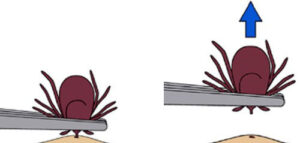Save your tick for testing!
If you have been bitten by a tick, sending it out for identification and laboratory testing is one of the most effective measures you can take to determine your risk of exposure to Lyme disease and other tick-borne illness. If you discover a tick, promptly remove it using either fine-tipped tweezers.

Grasp the tick as close to the skin as possible and pull upward with even pressure. Do not twist or use alternate methods of tick removal as you may dismember the tick (leaving its mouth parts lodged in your skin). Do not use other methods such as burning it, squeezing it or covering it in petroleum jelly, oil, nail polish, or other solutions. This approach may create stress causing the tick to regurgitate more of its contents into your blood stream.
I’ve removed the tick. What now?
If you cannot submit the tick for testing right away, that’s OK. Here are 4 practical ways to save a tick for testing. These methods can keep your tick safe from weeks to years. When you are ready to mail your tick for testing, just follow our tick submission guidelines.
Saving your tick for weeks at room temperature.
Option 1: Place your tick in a Ziploc bag, place the bag into a second bag (double bag), and label the date and location of the tick bite. Store the bag away from heat or intense sunlight. For example, do not leave your specimen inside the car during the summer months. If your tick is dismembered, cold storage is recommended for any length of time (see below).
Saving your tick for months in the cold
For longer periods of time, your tick should be stored at lower temperatures. Ticks like all other biological samples may degrade over time when stored at room temperature. Storing your tick at lower temperatures will improve tick testing in the following ways:
- Lowers the risk of microbial contamination (i.e. mold).
- Lowers the risk of morphological or genetic changes since metabolic activity is reduced.
- Storage in the fridge or freezer provides a constant temperature which reduces the risk of bio-degradation.
Option 2 (1-3 months): Place your tick in a Ziploc bag, place the bag into a second bag (double bag), label the date and location of the tick bite and store it in the refrigerator.
Option 3 (>2 months): Place your tick in a Ziploc bag, place the bag into a second bag (double bag it), label the date and location of the tick bite and store it in the freezer.
Saving your tick for years in ethanol
Option 4 (1-2 years): Place the tick in a seal-able container containing 70% ethanol (i.e. 70% Ethyl Rubbing Alcohol at Walgreens). Label container and store in the refrigerator. Why use ethanol? Not only does ethanol prevent mold, it also drives out water from tick, thus dehydrates the tissue and preserves the DNA.
I left my tick out! What now?
Well, if you have unknowingly stored your tick on the shelf for 3+ months and now you or a loved one are experiencing symptoms that may be related to the tick bite, it is still worth sending your tick to the lab. First, we will be able to identify the type of tick that bit you. Different types of ticks carry different types of diseases. Second, dry specimens can sometimes be tested for up to 10 years if other factors such as mold and/or fluctuating temperatures have not been an issue during that time.
Our test will determine whether your specimen can be accurately tested for Lyme and other tick-borne diseases. Specimens that do not pass our DNA standards receive a full refund for the cost of the test.

